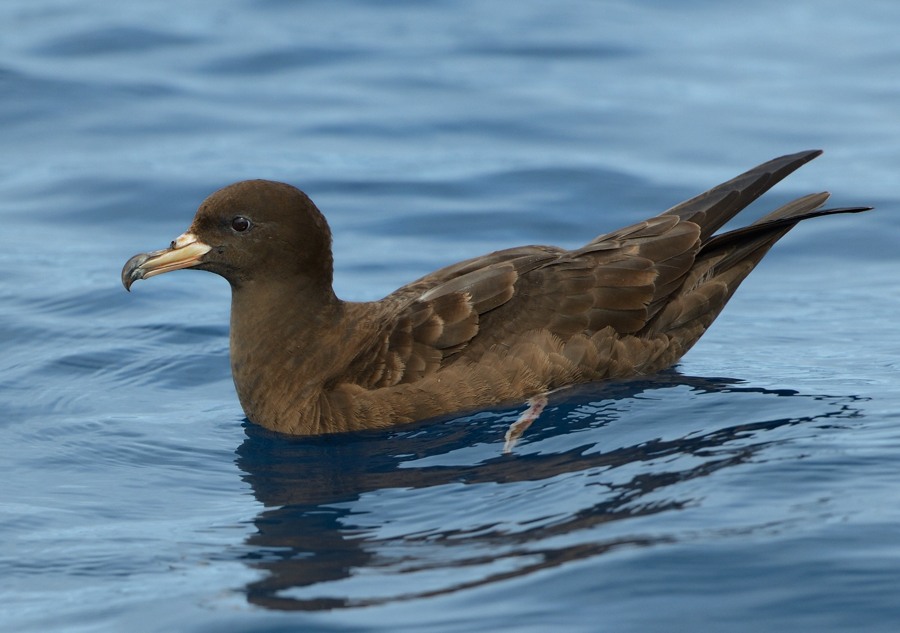
A Flesh-footed Shearwater rests at sea, photograph by Kirk Zufelt
The Conservation Services Programme (CSP) of New Zealand’s Department of Conservation works to reduce the impact of commercial fishing on protected species in New Zealand fisheries waters. Here are summaries of two of its most recent final reports by ecological consultancy Wildlife Management International on the globally Near Threatened Flesh-footed Shearwater Ardenna carneipes, a species that has been identified for listing by ACAP (click here).
Lady Alice and Ohinau Island
This report covers the findings from the first year of flesh-footed shearwater (Ardenna carneipes) research under Conservation Services Programme project POP2021-04. Here we report on the ongoing population monitoring of flesh-footed shearwaters on Ohinau and Lady Alice Islands. An updated population estimate for Titi Island, Marlborough Sounds is presented in a separate report.
During the 2021/22 season we monitored 261 and 302 study burrows on Ohinau and Lady Alice Islands respectively. The breeding success (burrows with an egg that produce a chick that is likely to survive to fledging) on Ohinau Island was 59%, similar to the 58% measured in the 2020/21 season. Breeding success on Lady Alice Island was 51%, which was also similar to the 48% measured in 2020/21 season. There were no detectable differences in breeding success between study and burrowscope (control) burrows, indicating no impact of handler disturbance. We were able to identify 73% of the birds in breeding study burrows on Ohinau Island and 93% in burrows on Lady Alice Island. An additional 349 and 165 flesh-footed shearwaters were banded on Ohinau and Lady Alice Island respectively.
Titi Island
This report covers the findings from the first year of toanui/flesh-footed shearwater (Ardenna carneipes) (Threat Status - At Risk: Relict) research under the Department of Conservation’s Conservation Services Programme, project ‘DOC CSP POP2021-04’. Here we report on the flesh-footed shearwater population estimate undertaken on Titi Island, Marlborough, to update previous estimates made in 2010 and 2014 (Baker et al. 2010 and Waugh et al. 2014).
Burrow transects were carried out on Titi Island to gather data for an updated population estimate for flesh-footed shearwaters known to breed on the island. It is estimated that there are a total of 528 (250 – 806, 95% CI) occupied flesh-footed shearwater burrows on Titi Island with an average burrow occupancy of 15% calculated across all colony areas. Through this transect work, it was also possible to calculate a population estimate for the tītī/sooty shearwaters (Ardenna grisea) (Threat Status - At Risk: Declining) breeding on the island. It is estimated that there are a total of 1,038 (544 - 1,533, 95% CI) occupied sooty shearwater burrows on Titi Island with an average burrow occupancy of 25%, calculated as an average across all colony areas.
The flesh-footed shearwater population estimate presented here for Titi Island is slightly higher than the previous estimate carried out by Baker et al. (2010) and Waugh et al. (2014). We conclude that our estimates are not necessarily reflective of a population increase, but more likely a result of more in-depth and higher-quality sampling and analysis techniques giving a more accurate estimate of population sizes compared to the two previous estimates. We recommend another future population estimate be undertaken in 5 years, utilising the same methods to support long term population trend analyses on Titi Island.
References:
Burgin, D., and Ray, S. 2022. Flesh-footed shearwater population monitoring and estimates: 2021/22 season. POP2021-04 final report prepared by Wildlife Management International Limited for the Department of Conservation, Wellington. 24 pp.
Burgin, D. & Lamb, S. 2022. Toanui/flesh-footed shearwater (Ardenna carneipes) population estimate for Titi Island, Marlborough Sounds: January 2022. POP2021-04 final report prepared by Wildlife Management International Limited for Department of Conservation, Wellington. 23 pp.
Both reports are available from here.
John Cooper, ACAP News Correspondent, 26 December 2022

 English
English  Français
Français  Español
Español